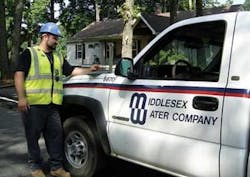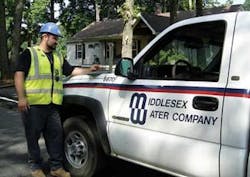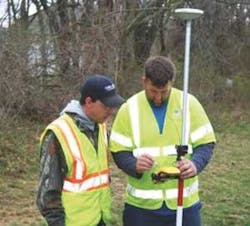Effective Use of Mobile Workforce Management
by Guerry Waters
Water utilities have a well-deserved reputation for doing more with less and they try hard to keep rates low. When it comes to technology, they are far more likely to place a higher priority on customer needs such as water treatment and infrastructure improvements than on office and field operations.
Increasingly, however, water utilities are finding that failure to provide field crews with up-to-date technologies is "penny wise and pound foolish." An up-to-date mobile workforce application can address all three of a water utility's major goals:
- Reduce operating and maintenance costs, thus maximizing revenue available for infrastructure improvements.
- Supply enough trained workers into the field to install and maintain the infrastructure.
- Maintain and improve customer satisfaction.
Utility-Specific Needs
Water utilities choosing mobile workforce applications today may initially consider generic field service software proven to work for many different types of businesses. Utilities that have gone this route, however, have almost invariably found these systems less than satisfactory. The reason is that utility field crews and service structures differ significantly from those of most other businesses.
Utility field crews must move rapidly among a wide variety of tasks — a routine maintenance check, a new meter installation, a major emergency involving explosions and broken water mains, etc. In contrast, field workers in most other businesses perform a single task, such as equipment repair or vending machine servicing.
The variety of work means that utility field technicians have a wide range of skills and often different levels of certification. They are not interchangeable. Each is unique. As a result, the software managing this complex utility workforce must accurately track the locations from which, during emergencies, individuals with certain skills and certification levels are deployed.
This detailed location tracking is uncommon in generic business applications, including those that accommodate mixed-skill crews. In construction, for instance, the number of crew locations tends to be much smaller. And, since generic construction crews are rarely if ever called on for emergency response, close tracking of skill level is far less important.
Most businesses do not need to monitor minute-by-minute activity of an individual or crew; in fact, doing so would generally be counter-productive. Utilities, however, require close monitoring to fulfill their obligations to guard public safety and inform public officials about progress toward ending emergencies.
Utility field crews are not the only workers who face sometimes-dangerous situations. But utility field situations are far more likely to endanger not just utility personnel but also members of the public. For example, an explosion may have broken both water and gas mains and downed nearby electric wires — a situation that could hit the local community hard if crews fail to follow strict safety procedures. A good utility field application will provide the tools to make sure crews follow all the safety and work procedures that minimize risk to themselves and others.
Routine utility field service work (meter disconnect/connect, meter installs, change replacement, and testing) and construction/maintenance work also have requirement sets not common to other businesses. Thus the mobile workforce application must be geared to handling the specifics of local infrastructures and the necessity of water delivery.
While virtually all local jurisdictions have water regulations and infrastructure, there may be little uniformity. Utilities that serve multiple jurisdictions need a mobile application that tracks and accommodates these differences. In contrast, generic mobile applications intended, for instance, for delivery services must accommodate only a generally uniform set of driving regulations and conventions.
Almost all organizations choosing field service applications seek improvements in customer satisfaction. Again, however, utility and other industry goals differ. Generic business applications commonly emphasize meeting appointments and notifying customers of delays. Utilities have those requirements, too. However, the speed of response to emergencies and repair needs is far more important. In a generic mobile application, the ability to "squeeze in" a customer for an earlier appointment may well earn customer loyalty and repeat business. But utility stakes are far higher because homes and businesses are all but uninhabitable without water service.
Coverage
To address these goals, mobile workforce applications include a number of different functions:
• Scheduling. Any field service application can set up a schedule. But the reality is that a utility's 8:00 a.m. schedule is frequently irrelevant by 8:30 a.m. as emergencies crop up. Utility schedulers must provide rapid, intra-day, "real-time" rescheduling. With it, workers resolving an emergency receive new schedules that start from the current location to minimize driving while also addressing priority tasks. Such schedulers significantly increase post-emergency workforce productivity.
Scheduling involves more than just workers. The best applications offer scheduling for daily tasks and for tasks whose completion date may be far into the future, such as a meter inspection project. Applications should also be able to group tasks geographically to minimize driving.
• Routing. High fuel prices place a premium on software applications that identify fuel-efficient routes and the drive-time ramifications. Especially helpful are applications that can route workers to locations other than a customer address — to a main break at "Fifth and Washington" or "about a mile south of the Route 70/Wilson Turnpike interchange."
• Communications from/to the field. This aspect of mobile workforce software is one of the most important in terms of cost savings. It permits technicians in the field to receive schedules and assignment details on hand-held or laptop devices. Technicians can then report on the real-time progress toward completion of the day's tasks. Wireless connectivity also enables utilities to consider home-based reporting. This allows technicians to head to their first work assignment from home and go directly home at the end of the day. By eliminating centralized morning assembly and evening reporting, one utility expanded the time that crews worked on tasks by an hour and a half daily while also reducing both employee and utility fuel consumption.
Mobile workforce applications for utilities should offer communications flexibility, of course. Some utilities will want to center communications on a dispatch center. Others will want to distribute communications among customer service representatives.
• Work assistance. In the field, mobile workforce management software can substitute for expert supervision. It can guide workers through each of a task's steps. Information on mobile devices also reinforces previous training. Newer employees thus become more productive in less time. And all workers complete tasks more quickly when they can look up information on handhelds rather than thumbing through a messy pile of paper manuals.
Work assistance functions also increase safety, an issue of particular concern to utilities with aging workforces. Currently, many utilities count on experienced workers to carry safety techniques and procedures in their heads. Mobile workforce software can incorporate that knowledge and make it accessible via tools like checklists and configurable order completion workflows. As a result, utilities can train technicians more quickly, ensuring they meet safety and compliance guidelines.
• Vehicle monitoring. With GPS-based automatic vehicle location (AVL), automated scheduling systems can consider technician location when determining the closest technician to priority orders, resulting in faster response. And sharing the real-time status of the order with customer service representatives makes them better able to inform and assist customers.
Use of mobile workforce software has ramifications that go beyond fieldwork. It can:
- Bolster "just in time" asset strategies by permitting workers to report parts used from on-line mobile devices in near real time.
- Better track repairs customers must pay for, thus increasing billing accuracy.
- Help managers identify skill shortages and create business cases that prioritize hiring by identifying patterns of tasks frequently delayed.
- Keep customers informed about work in their neighborhoods, which is particularly effective when customer service representatives have access to real-time progress reports on fieldwork.
Conclusion
Many water utilities today have minimal or no field service automation. It is increasingly clear, however, that this type of short-term saving results in higher long-term expenditures. Software that manages the mobile workforce can substantially reduce fuel costs and overtime. It also increases project management efficiency.
Utilities moving from paper-based trouble tickets and dispatching to an automated mobile workforce system typically find that the software pays for itself in well under two years. After that, savings can go straight into infrastructure repair and expansion — an investment that will continue to pay off for years.
About the Author:
Guerry Waters joined the Oracle Utilities Global Business Unit (previously SPL WorldGroup) in 2000. He focuses on IT strategies that help utilities meet their goals amidst changing customer demands, regulations, and market structures. Previously, Waters was Vice President of Energy Information Strategy at META Group (now Gartner) and CTO and Director of Technology Strategy and Engineering at Southern Company.


